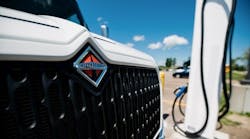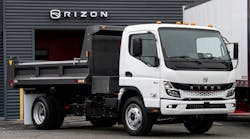Building the perfect green truck for the longhaul trucking segment is particularly challenging since there is little consistency in terms of terrain and fuel stops. At the same time, most trucks in this segment feature sleeper berths for the driver — and those require a lot of energy to power amenities such as heating and cooling systems.
The first step is to spec a vehicle as aerodynamic and light as possible. Aerodynamically shaped cabs, bumpers and fuel tank skirts can improve fuel efficiency by as much as 1 to 2% at highway speeds. Wide-base tires on a tractor's drive axles and trailer can save 1,000 lbs., boosting fuel economy by as much as 0.2 mpg.
Next are changes to the truck's power signature. Smaller engines, say 475 hp. vs. 550 hp., for example, help reduce fuel consumption. An automated mechanical transmission (AMT) shifts at precisely the right moment at the right engine rpm for the best fuel economy every time — improving fuel economy by a minimum of 0.1 mpg. This allows the fleet to recoup the higher sticker price of an AMT on average in 18 months through that fuel savings.
Reducing the top speed of on-highway trucks via engine governors not only adds to fuel savings, but substantially reduces emissions as well. Con-way Truckload, Joplin, MO, cut the top speed of its trucks down to 65 mph from 70 for its fleet of 2,700 units, a move expected to save 2.8 million gal. of fuel per year and reduce annual carbon emissions by 62 million lbs.
Using a B20 biodiesel blended fuel can also reduce a truck's carbon footprint, though a fleet will pay for it with 1 to 2% lower fuel economy and a slightly higher price per gallon.
Battery-powered auxiliary power units (APUs) are now in position to offer the best solution in terms of energy for the sleeper berths without any emissions — a key consideration in terms of stringent anti-idling laws that, in California's case, extend even to diesel-powered gensets. For example, Paccar's Clean Power system uses four dedicated deep-cycle batteries that have the capability to provide engine-off cooling and heating, plus 120V power for hotel loads from the sleeper for up to 10 hours. The batteries are recharged as the truck is driven down the road or from “shore power” at a terminal or truck stop.
The ultimate longhaul green truck configuration, though, is most likely a diesel-electric hybrid — a model in prototype testing with Wal-Mart Transportation. Designed by Paccar and Eaton, it combines a diesel engine and AMT with a parallel-type direct hybrid system that incorporates an electric motor/generator and battery pack. The system captures energy generated by the diesel engine and recovers energy normally lost during braking, then stores it in the batteries. That electric torque is blended with engine torque for improved fuel efficiency and emissions reduction.
The batteries power the heating, a/c and electrical systems while the engine is off — activating the engine for short recharge periods to top off the power supply.


